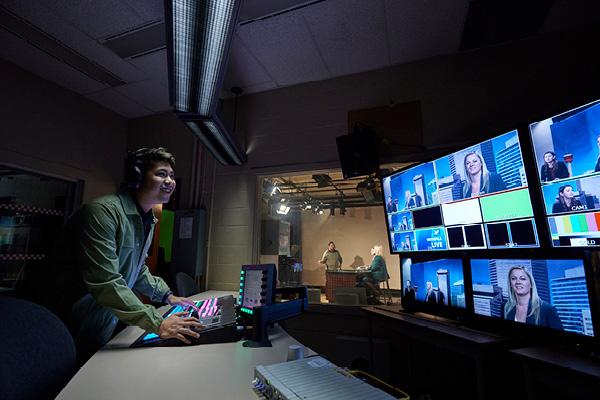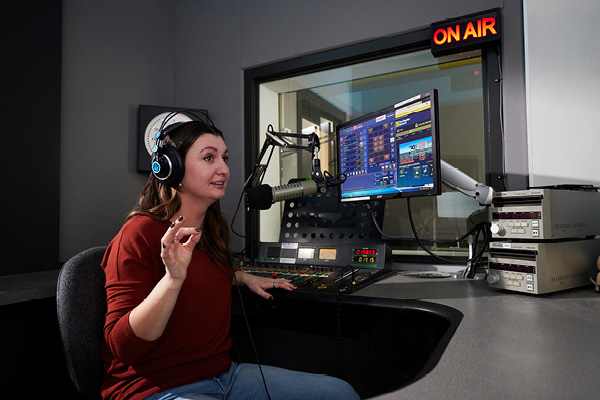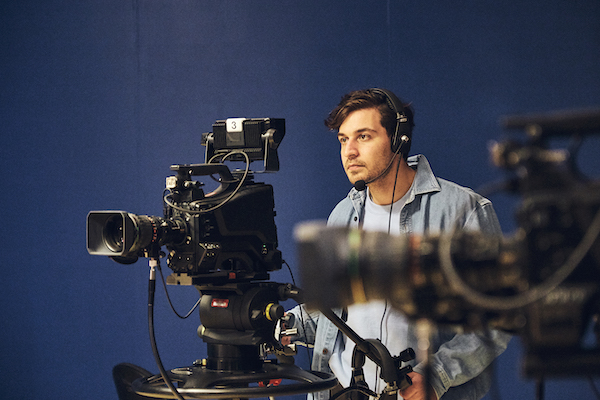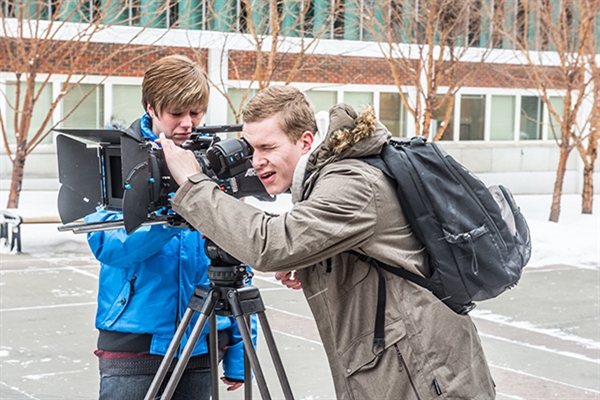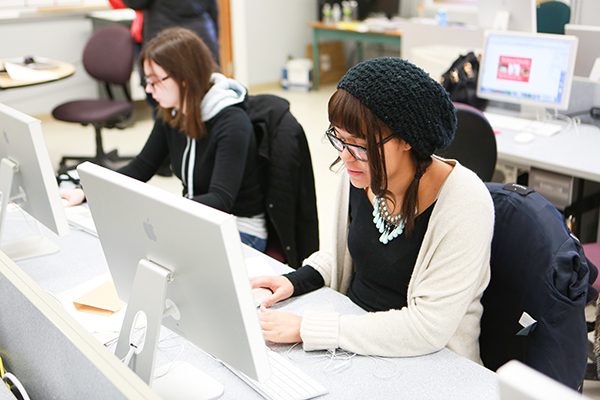On this page:
Overview
Are you ready to step into the spotlight and make your mark in the world of media? The Radio, Television, and Broadcast News program’s Broadcast News major is your gateway to an exciting career as a news or sports anchor.
Maybe you’d like to be a sideline host for Hockey Night in Canada? Or a content creator with your own YouTube channel, podcast or website? This program will help you get there.
Hands-on training for the real world
You’ll receive extensive, hands-on training that equips you for the broadcast environment. We understand the importance of real-world experience, and you’ll have plenty of it.
Journalistic integrity and deadline respect
Our curriculum emphasizes the core principles of broadcast journalism, instilling in you the value of journalistic integrity. You’ll learn to craft compelling stories while upholding the highest ethical standards. You’ll master the crucial skill of meeting deadlines.
Diverse roles in real-life simulations
Prepare to wear many hats! In our real-life simulations, you’ll take on various roles that mirror the dynamic world of broadcast news.
Whether you’re a reporter on the frontlines of breaking news, a producer orchestrating a live broadcast, a web editor shaping online content, a newscaster or sports anchor, a live reporter capturing events as they unfold or a weather presenter, you’ll gain invaluable experience that sets you apart.
Challenging, creative, and career-ready
Our broadcasting program is designed to challenge your skills, stretch your creativity, and prepare you for a rewarding career in various media-related fields.
This program involves two years of full-time study, along with an industry practicum in your fourth semester.
You’ll emerge with a solid content creation and broadcasting foundation, ready to make your mark in the industry.
Those in the broadcast field are innovative, social, and methodical.
You need:
- curiosity
- initiative, persistence and resourcefulness
- objectivity and integrity
- creativity
- an accurate memory
- communication and interview skills
- research and critical thinking skills
- physical and emotional stamina to cope with the pressures of competitive, fast-paced work
- solid news judgment
- an interest in people and current events.
You should enjoy finding new approaches to stories, dealing with people, generating interest in news stories, and compiling information methodically. You will also need composure and poise on camera or the microphone.
The opportunity to advance your education by transferring into this program or gain credit for previous postsecondary courses may be available.
There may also be opportunities to further your education once you graduate.
Learn more about program and institution transfer options.
In your final semester, you will complete a four-week practicum placement with an approved media-related employer.
Upon successfully completing this program, you will receive a SAIT in Radio, Television and Broadcast News diploma with a major in Broadcast News.
Careers and opportunities
Each year, SAIT conducts a survey between February and April to determine the employment rate, salary and satisfaction of our newest SAIT alumni.
![]() 100% graduate employment rate
100% graduate employment rate
![]() $48,500 average starting salary
$48,500 average starting salary
Find out more about our graduate employment statistics >
Our graduates may work in the following occupations. Some careers require additional experience and education.
Associated National Occupational Classification (NOC) codes: 51110, 51111, 51112, 51113, 50011, 52114.

Career counselling and support
Unsure which career path is for you? SAIT offers career planning services to help you decide your future.
You can also get started by taking our online career finder quiz, which can help you narrow down your search based on your current skills and interests.
Finally, you can also head to Alberta alis for various tools and resources, including additional quizzes and labour market information to help you narrow down a career path.
Services and workshopsCourses
The Radio, Television, Broadcast News - Broadcast News diploma requires 60 credits (21 courses) to complete.
The program spans two years, with two semesters each year.
| Course | Credits |
|---|---|
|
Learn the various roles in technical operations of broadcast news. Operate an ENG camera, record audio components, edit in non-linear editing software and mix it all together to produce newscast. Pre-requisites:
|
3 |
|
This intermediate course continues instruction in audio and video production and operations specifically for Broadcast News. Students are expected to create programs using production techniques, field and telephone recording, and newsroom equipment to a near ‘air ready’ level. Learners continue to build their skills in video production ENG (Electronic News Gathering) including camera and editing in the “television news” style. Pre-requisites:
|
3 |
|
This course provides instruction in audio and video production and operations designed specifically for Broadcast News learners. Assignments are given on program creation, production techniques, field and telephone recording, and newsroom equipment. Further, the broadcast news learner is introduced to the fundamentals of video production ENG (Electronic News Gathering) including camera and editing in the “television news” style. Pre-requisites:
|
3 |
|
This course is an introduction to computer fundamentals with emphasis on skills training. Theoretical components include Internet technology and terminology. Practical skills include file management, basic skills in word processing, spreadsheet applications, and presentation applications. Web applications and webpage design skills will be developed. |
1.5 |
|
The focus of this course is to develop and assess the writing skills essential for the broadcast industry. Topics include scriptwriting fundamentals, grammar, styles, script formats, research, and development of interview questions. |
3 |
|
Introduction to Broadcast News introduces learners to the principles of broadcast journalism and the role of the broadcast industry. They will learn to examine current events, sources, critical news judgment and the basics of interviewing as they relate to potential roles in broadcasting. In addition, learners gain hands-on experience in producing a basic television news program. |
3 |
|
Learn to research, fact-check and source information using digital tools. Write for online audiences. Using the latest digital technologies, develop interactive stories on multiple platforms (outside of mainstream media). Pre-requisites:
|
3 |
|
Learn to write and rewrite copy for a radio newscast. Determine story lineups. Emphasis is on developing a clear, concise and literate writing style. Apply voiced reports, taped actualities, and sound during a simulated radio newsroom operation. Pre-requisites:
|
3 |
|
Learn the basics of television news production. Write, create and deliver an on-air newscast. Develop oral presentation skills while participating in a simulation of presenting a news or sports show. Pre-requisites:
|
3 |
|
Learn reporting basics: finding/assessing story ideas, developing sources, structuring a story for radio and television. Develop best practices for interviewing and writing news gathered in the field. Pre-requisites:
|
3 |
|
This course advances journalistic skills including online writing, the use of digital tools and website management. Gathering/publishing news in the field on multiple platforms will help the learner sharpen news judgment and ethical awareness while building an online brand. Pre-requisites:
|
3 |
|
In this intermediate course learners continue to write and rewrite news, sports, and weather copy and determine the appropriate lineup of a newscast as part of the radio news lab simulation. The course material requires a clear, concise and literate writing style, and explains the importance of format and the use of voice reports, taped actualities, and sound for radio news, sports, and weather. Learners are actively involved with the radio students in radio simulation which includes on-air presentation of news, weather and sports. On-air presentation for radio is taught and critiqued. Pre-requisites:
|
3 |
|
This course prepares the learner to write and rewrite news, sports, and weather copy and decide the lineup of a newscast in preparation for the television news lab simulation. Lectures and class work deal with the basic responsibilities of the producer, and the news, weather, and sports anchors. Learners are actively involved in the production of short TV news programs. Oral interpretation of written text and on-air presentation for television is taught and critiqued. Pre-requisites:
|
3 |
|
This intermediate course continues beat and field reporting on a wide variety of topics and situations. The course emphasizes the ways in which broadcast journalists access and report on information. Intermediate skills in interviewing and writing for field reporting are highlighted. Pre-requisites:
|
3 |
|
In this course, learners actively participate in the daily running of the Newsroom through frequent updates and contributions to the web and a variety of social media platforms. Pre-requisites:
|
3 |
|
In this course, learners run all aspects of the radio newsroom in conjunction with the radio students in radio simulation. Components of this course may be used in the BN Capstone course. On-air presentation for radio is critiqued. Pre-requisites:
|
3 |
|
In this course, learners complete all of the Broadcast News components for a longer format Television News program in cooperation with the Television students. Components of this course may be used in the BN Capstone course. On-air presentation for Television is critiqued. Pre-requisites:
|
3 |
|
This course provides emerging and existing leaders the opportunity to explore the concept of leadership and to develop and improve their leadership skills. The participant gains an understanding of leadership, articulates a personal philosophy of leadership, and applies various leadership skills. Involvement is accomplished through assigned readings, discussion, role playing, experiential activity, use of multimedia, journal writing, and extracurricular project and leader shadowing. |
1.5 |
|
Audio Video Production introduces learners to the basic tools and techniques of audio and video production. Learners develop production skills, forming the basis for advanced Radio, Television, and Broadcast News program elements. Through practical experience, learners explore digital audio production, audio/video editing, interview production, camera composition, single camera production techniques, and visual storytelling production and planning. Equivalents:
|
3 |
|
Creative expression and the concepts of dramatic, mental and physical involvement in performance are key elements to a future broadcasting career. Students study the foundational elements of improvisation, movement, dramatic interpretation, voice production, articulation, enunciation and public speaking. |
3 |
|
In this course students will complete two distinct elements. Students will plan and execute a small group project of their choice, demonstrating their applied learning. Further, students will research and complete a 4-week practicum placement with an approved media-related employer. Pre-requisites:
|
3 |
Progression
Students must attain a PGPA and/or a CGPA of 2.0 or better in each semester and pass the necessary prerequisite courses to progress through the program. To qualify for graduation, students must pass all courses, attain a CGPA of 2.0 or better and complete course requirements within the prescribed timelines.
Review our grading and progression procedure >

Explore your options!
Some courses in this program are available through Open Studies. You can complete courses via Open Studies to get a head start on your education, reduce your course load once accepted into a credentialed program, or determine which career path best suits you before you fully commit.
You may also take courses for general interest or personal and professional development.
Available Open Studies coursesAdmission requirements
Applicants educated in Canada
Applicants must demonstrate English language proficiency and meet the following requirements or equivalents.
- at least 60% in English Language Arts 30-1 or 30-2 or equivalents.
SAIT accepts high school course equivalents for admission for applicants educated outside Alberta.
All applicants who were educated outside of Canada must demonstrate English Language proficiency and provide proof they meet the program admission requirements with an international document assessment. Find out what educational documents are accepted and assessment options.
SAIT may also accept courses completed at certain international post-secondary institutions.

Academic Upgrading
Missing an admission requirement for this program? Upgrade your prior education to help you receive admission into one of SAIT's career programs.
Upgrade
English language proficiency
All applicants must demonstrate English language proficiency prior to admission, including students educated in Canada.
Learn moreAvailable intakes
Costs
2024/25 tuition and fees
The following costs are effective as of July 1, 2024.
Domestic students
Books and supplies are approximately $1,000 - $1,500 per full-time year.
This is a bring-your-own-device program with a standard computer hardware and software requirement. See the specific requirements on our computers and laptops page.
Find your booklist on the SAIT Bookstore's website. The booklist will be available closer to the program start date. Can’t find your program or course? The bookstore didn't receive a textbook list. Contact your program directly to determine if they’re still refining course details or if you're in luck; no textbook purchase is required this term.
2023/24 tuition and fees
The following estimated costs are effective as of July 1, 2024.
Domestic students

Financial aid
Paying for your education may feel overwhelming, but we have resources and programs that can help, including information about payment options, student loans, grants and scholarships.
Learn moreApplication process
When applying in the application portal, select Radio, Television and Broadcast News. You will be able to select Broadcast News as your major during the application process.
Ready to apply?
Follow our step-by-step guide to submitting a successful application.
Communication during admission
Email is the primary source of communication during the selection process. Ensure your personal email account is managed appropriately to receive our emails, files and communications. We recommend you add the sadt.advising@sait.ca domain to your safe senders' list or you risk missing critical email messages.

Begin your application
Apply now using the online application portal.
Ensure you have a valid Visa or Mastercard to pay the non-refundable application fee of $120 for domestic applicants or $150 for international applicants.
Apply nowInformation sessions
Prepare for a strong start in your chosen program or get the details you need to decide your future path.
Our expert staff and faculty are ready to answer your questions and provide information about the following:
- What sets SAIT apart
- An introduction to the program and area of study
- Admission requirements
- Future career paths
- Information on the earning potential and graduate employment rates.
Contact us
School for Advanced Digital Technology Advising
-
Phone - 403.284.8543
-
Email - sadt.advising@sait.ca
International Student Advising
-
Phone - 403.284.8852
-
Email - international@sait.ca
Subscribe for updates
Your journey starts here! Sign up to get important updates on:
- Technology Programs
- Application information
- Relevant news and events
